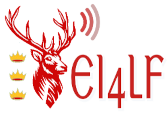

| EI4LF | Primers | Baofeng UV-9R PRO |
Welcome to the EI4LF amateur radio page |
Baofeng UV-9R PRO handheld 2m/70cm RadioThis primer considers the Baofeng UV-9R PRO handheld radio and gives some tips on seting it up and connecting to local repeaters. Last updated: 25 August 2023 1. IntroductionThe Baofeng is a small, light weight, waterproof to IP-68 standard, handheld radio that covers both the 2m Very High Frequency (VHF) [144-146MHz] and the 70cm Ultra High Frequency (UHF) [430-440MHz] bands. It is battery powered with an operating voltage of 7.2V.
Note the various buttons and knobs on the radio. The next section describes the functions allocated to each of the keys in the keypad and some more information. 1.1. Abbreviations
[~] Frequency Mode, also called Variable Frequency Oscillator (VFO), is an operation mode where the Transmit (TX) and Receive (RX) frequencies are adjustable in the specified range. [$]Channel mode, channels are pre-programmed and the frequency is not adjustable. [^] VOX also referred to as Voice Activated Transmission is a feather that puts the microphone into continuous listening mode for the operatoes voice. When voice is detected it will then automatically start broadcasting. [*] Continuous Tone Coded Squelch System (CTCSS) is a type of analogue in-band signalling system, sometimes referred to as tone squelch, that adds a low frequency audio tone to the voice signal. This tone can be detected by other users on the same radio frequency and their radio can mute those users who are using a different CTCSS tone or no CTCSS tone. CTCSS tones range from 62.5 to 254.1 Hz giving 51 unique tones. [+] Digital-Coded System (DCS) or Continuous Digital-Coded Squelch System (CDCSS) performs a similar function to CTCSS; however, it is digital in nature. It adds a 134.4 bps (sub-audible) bitstream to carry digital data or encoded-words as a form of digital squelch DCS to the transmitted audio. This is received by others on the same radio frequency and like with CTCSS the radio can mute those users who are using a different code or no code. There are 83 codes carried in a 23 bit word, the Golay (23,12) code, which includes error correction parity bits such that the radio has the ability to detect and correct any three bit or less error that occurs in the 23 bit word. The UV-9R PRO has 105 codes, using codes beyond the 83 defined in the ANSI/TIA-603-E (2016) standard will reduce/eliminate the ability for error correction. 2. Factory Default the UV-9R PROThe following outlines the procedure for factory defaulting the radio.
3. Changing Frequency in VFO Mode
Consider image 3. above. When the radio is turned on, it is in either Frequency Mode [~] or Channel[$] Mode. To switch between them, turn the radio off with the volume control knob. With the MENU key depressed, turn the radio on again and the mode will have switched. Bring the radio to Frequency Mode. Type in the required frequency with the keypad. 4. Setup a link to a VHF repeaterRepeaters managed and installed by clubs allow the operator to extend their range to that of the repeater network. The operators radio connects to the repeater and all those within the repeater and any other repeaters that it is connected to will be part of a large single radio net. Typically in VHF the repeater TX is on one frequency and the RX is offset from the TX frequency by -0.6MHz. Take for example EI2REG (MH: IO52KK) located at Rooskagh East, West of Newcastlewest in County Limerick. The frequencies alotted to it are:
In Frequency Mode enter the Repeater TX frequency (as the UV-9R PRO's receive frequency).
As illustrated in Figure 4, to set this up:
Setting the handset receive frequency Setting the Offset Setting the Transmit CTCSS
Now that a connection is made to the repeater it makes sense to save it to a channel. In this case save it in Channel number 000.
Note: To delete information from a channel, use the MENU key and type in [2][8]. Press the MENU key, select the channel to be deleted and press the MENU key once more to confirm.
The process to setup a link to a UHF repeater is identical except that the offset is now +1.6MHz. Consider the Woodcock Hill repeater (EI7WHR) located on the Limerick/Clare border near Meelick (MH: IO52PQ).
|
  |
Copyright © 2025 C²S Consulting |